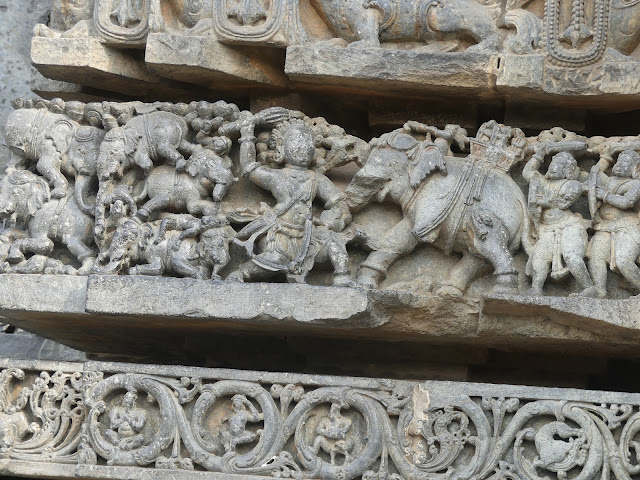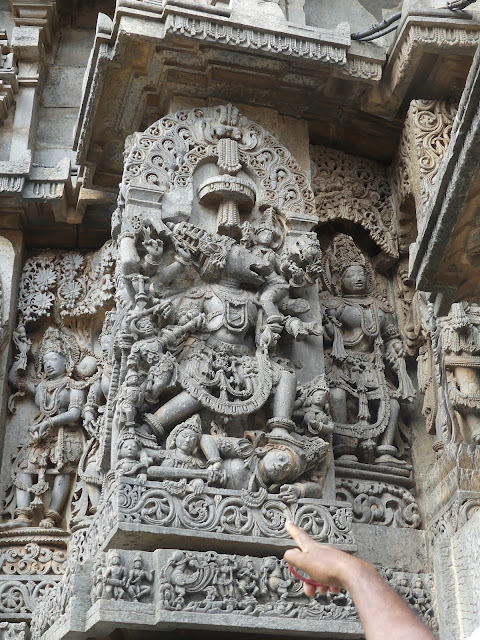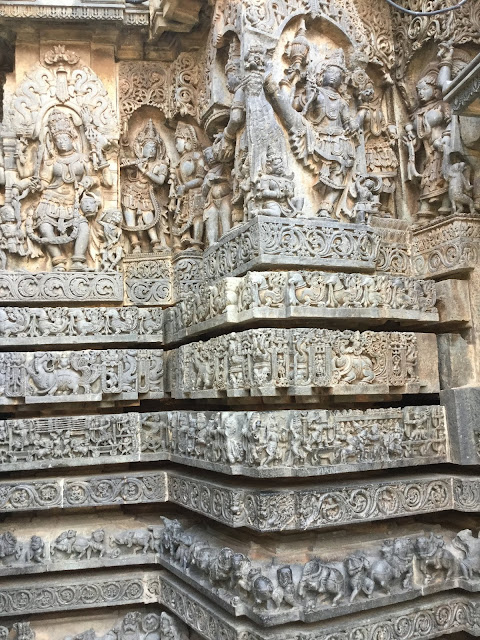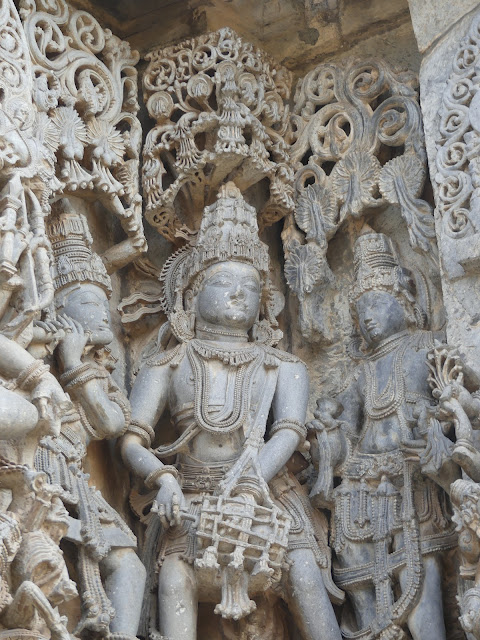 |
| HOYSALESHWARA TWIN TEMPLE The twin temples of Halebidu are believed to be dedicated to Hoysaleswara and Santaleswara Shiva lingas. This is the Entry Gate for Santaleswara Temple |
 |
| Vesara Style of Architecture: North Indian ( Nagara) and South ( Dravida ) Indian Temple Architecture |
 |
| Our Hoysala Temple Visit |
I visited this temple twice. During second visit I found it much more interesting.
It is known that this famous temple derived its name from the King Vishnuvardhana Hoysaleswara, who built the temple. A large amount of contribution was received from the Shaivas for the construction of the temple. It was built to compete with the Chennakesava temple which was under construction as a Vaishnava temple. Star shaped temple platforms and fine intricate carvings on the outer walls are the main characteristics of the architecture. The Hoysaleswara Temple is surrounded by ponds, mantapas and lakes. It is well known for the sculptures and architecture of Hoysala period.
The temple has exclusive carvings and has a plan with two shrines, one for the King and one for the queen. It has about thousand figures on the walls which depict scenes of Mahabharata and Ramayana. It reflects the Hoysala architecture and was built in soapstone. The outer walls of this temple have intricate carvings and the temple has been described as an outstanding example of Hindu architecture.
The temple has four porches for entry and the main shrine faces on the east. There are exquisite sculptures and paintings inside the temple. There is an image of a dancing Ganesha at the entrance of the temple. There are more than 240 images in the temple and no other temple has these many intricate sculptures. The most interesting part of the temple is the Garuda Sthamba, which is a rare pillar that depicts the history of the bodyguards that lived with the Kings in olden days. These bodyguards committed suicide on the death of their master and this pillar pays homage to a bodyguard named Kuruva Lakshma who killed himself after the death of his master. The event is narrated in detail on the pillar. This temple has been listed as a heritage site by the UNESCO.
There are very intricate carvings on all the walls of the temple. Most of these depict the lifestyle from the 12th century. And legends from the epics like Ramayana and Mahabharta are also carved on the temple walls. Overall, the temple is made of soapstone (metamorphic rock). Alongside the intricate carvings and depictions of legends, the temple is also rich in iconography and inscriptions in both North Indian and South Indian scripts.
The temple has four porches for entry and the main shrine faces on the east. There are exquisite sculptures and paintings inside the temple. There is an image of a dancing Ganesha at the entrance of the temple. There are more than 240 images in the temple and no other temple has these many intricate sculptures. The most interesting part of the temple is the Garuda Sthamba, which is a rare pillar that depicts the history of the bodyguards that lived with the Kings in olden days. These bodyguards committed suicide on the death of their master and this pillar pays homage to a bodyguard named Kuruva Lakshma who killed himself after the death of his master. The event is narrated in detail on the pillar. This temple has been listed as a heritage site by the UNESCO.
The concept of Twin Temples
The Halebidu temple is actually a twin temple. A twin temple consists of two shrines and two superspectrums. And these two are connected with each other. Furthermore, Each one of the temples contains a Shiv linga.
The interiors of the Halebidu temple are as beautiful as the outer walls. There are 4 entrances to each of the temple shrine. And the doors also had two doorkeepers statues on either side. While one of the doorkeeper statue is intact. But, some are damaged and one is completely missing. Across the north and south entrance, pillars run on either side in parallel inside the temple. Most of these pillars are also plain. And so are the walls. Particularly when compared to outside walls. But the four pillars right in front of the shrine have carvings on top of them.
There are very intricate carvings on all the walls of the temple. Most of these depict the lifestyle from the 12th century. And legends from the epics like Ramayana and Mahabharta are also carved on the temple walls. Overall, the temple is made of soapstone (metamorphic rock). Alongside the intricate carvings and depictions of legends, the temple is also rich in iconography and inscriptions in both North Indian and South Indian scripts.
 |
| WAR SCENE FROM MAHABHARTA : ABHIMANYU breaking Chakravyuha |
 |
| BHIMA Fighting the war . So many Elephants and soldiers are killed by Bhima . |
We see following stories carved in stone :
* Reclining
Vishnu with all gods and goddesses
* Prahlada-Hiranyakasipu-Narasimha
legend from the Bhagavata Purana
* Mohini as Bhairavi with Bhairava
* Rama
fighting Ravana from the Ramayana
* Indra seated; Brahma with Saraswati
* Karna-Arjuna and Bhima-Dushasasna legends from the Mahabharata
* Umamaheshvara and Ganesha
*A kissing scene between a man and woman ,musicians, dancers
* Mohini stories;
more courtship and kissing scenes
* Kali Shakti legends
* Arjuna legends
On the south-west outer wall of the northern Shiva temple we see standing
images of:
* Brahma, Shiva, Vishnu
* Durga, Saraswati, Kama and Rati, Parvati,
Indrakila legend
* Parvati doing yoga; Shiva is infatuated by Mohini
* Ramayana
stories including the golden deer, the first meeting with Hanuman and Sugriva,
Rama shooting an arrow through seven palms, Hanuman giving Rama's ring to Sita
* Mohini legends; reclining Vishnu on Sesha giving birth to the cosmic cycle;
Vamana legend; avatars of Vishnu; Shiva and Ganesha dancing together; twelve
Adityas from the Vedas; Arjuna-Bhisma legends; Shiva and Vishnu's female avatar
Mohini dancing together
• On the north-west outer wall of the northern Shiva temple you will notice :
* Nataraja in
Tandava dance; Durga and the Saptamatrika; legends of Abhimanyu, Drona, Krishna
with Arjuna in Mahabharata; Nataraja; eight forms of Rudra; Mohini dancing;
Bharavi; Sarasvati dancing, Shiva and Ganesha dancing, Angry Narasimha, various
forms of Vishnu, Dancing Ganesha with Gajasuramardana Shiva; Kartikeya; * * Parvati; dancers and musicians.
* Harihara (left half Shiva, right Vishnu)
 |
| SIVA PARVATI |
 |
| A close view of the detailing on the exterior of the temple which showcases warriors, mythical characters |
 |
| RAVANA lifting Kailasa : Siva Parvati on Kailasa |
In terms of theology from different Hindu traditions, the large images are seen on the outer walls of the west side:
* Shiva: as Umamahesvara , as Nataraja and destroyer
of various demons ,
* Dakshinamurti , as nude
Bhairava
* Shakti: as Parvati forms of Durga, Mahishasuramardini,
Kali and Vishnu: seated or standing ,Krishna as Venogopala ,Varaha ,Narasimha
,Vamana ,Trivikrama
· Harihara (half Vishnu, Half
Shiva)
· Ganesha:
· Kartikeya: on peacock ,under
seven-hooded serpent
· Brahma
· Saraswati: seated or standing
· Vedic deities: Indra, Surya and
others
· Others: Vishnu in his female
avatar Mohini clothed and nude, Shiva with Mohini, Arjuna and others
 |
| Lord Ganesha |
 |
| Ganesha and other Deities |
Carvings on the Halebidu temple wall
The outer walls of the Halebidu temple have very intrinsic carvings. The lowest layers consist of animal figurines like elephants, horses, lions etc. Then they are followed by miniature carvings of dancers, friezes narrating legends from the Hindu texts, makaras, peacocks. Thereafter, one can see the depictions of daily life of people in the next few layers of carving, including festivals. Also, ceremonies, mythical creatures, people standing and sitting etc are depicted in this layer. Then one can see different carvings depicting artha, kama, dharma scenes including courtship and eroticism. Thereafter there are large panels with bigger figurines depicting the deities of Hindu culture, and the mythical scenes from different epic stories.
One can see scenes like Durga killing a buffaloo. Or, Rama and his brothers going on an exile. And also Arjuna and Krishna episodes from Mahabharata and several other scenes. It requires sufficient time when we visit here and have a look at the carvings. Local guides will explain you in detail.
 |
| Bramha , Vishnu, Mahesha and Siva Parwati |
 |
| Hindu Gods and Goddesses |
 |
| OUTER WALL : DIFFERENT LAYERS OF CARVING |
 |
| NARSINHA |
 |
| This is Hoysaleswara ShivLinga ( For KING ) . Next to this is Santaleswara Shivinga ( For Queen ) |
The twin temples of Halebidu are believed to be dedicated to Hoysaleswara and Santaleswara Shiva lingas. These shiv lingas are named as Hoysaleshwara and Shantaleshwara .They are both equal and joined at their transept. It is said that while the king offered prayers to the masculine form and the queen worshipped the feminine one. Outside each of the twin temples, there is a Nandi shrine.
 |
| Two Garbha Griha |
Sanctum
The twin-temple has two sanctums (garbha griha), both with Shiva linga. One sanctum is dedicated to "Hoysaleswara" Shiva (the king) and the other for "Shantaleswara" Shiva (the queen, Shantala). Both are of equal size.The two sanctums are next to each other in a north-south alignment, both face east, and each have in front a mandapa .The temple was built with chloritic schist, more commonly known as soapstone. The soapstone is soft when quarried and easier to carve into intricate shapes, but hardens over time when exposed to air.
The twin-temple has two sanctums (garbha griha), both with Shiva linga. One sanctum is dedicated to "Hoysaleswara" Shiva (the king) and the other for "Shantaleswara" Shiva (the queen, Shantala). Both are of equal size.The two sanctums are next to each other in a north-south alignment, both face east, and each have in front a mandapa .The temple was built with chloritic schist, more commonly known as soapstone. The soapstone is soft when quarried and easier to carve into intricate shapes, but hardens over time when exposed to air.
 |
| The Nandi, sacred Bull of Siva is carved out of a single monolithic rock. This Nandi is bigger than the other Nandi in front of Shantaleshwara Linga |
With a huge statue of the Nandi facing the Shivlinga in the respective temple that it faces, one has to climb down the stairs of the main temple with the ShivLinga and then climb up the stairs of the Nandi shrine to visit it.
 |
| Madanakai |
Madanakai
In the central navaranga of each temple's mandapa are four pillars and a raised ceiling that is intricately carved. Each of the four pillars of this central Navaranga had four standing madanakai (Salabhanjika, mostly female) figures.
 |
| THESE DANCERS ARE ON THE BRACKET INSIDE MANDAPA |
The profusely carved doorway leading to the main hall is flanked by Dwarapalas.
 |
| VISHNU |
Narasimha, Saraswati, Brahma, Ganesha, Parvati and Shiva, Shiva and Parvati, Bhairava, Indrani, Keshava, Surya and are carved in bigger size on outer walls .
 |
| Saraswati and Ganesha |
 |
The walls on the other side have more large images.About 340 large reliefs depict the Hindu theology and associated
legends. Numerous smaller friezes narrate Hindu texts such as the Ramayana, the
Mahabharata and the Bhagavata Purana. Some friezes below large reliefs portray
its narrative episodes.
 |
| VARAH Avatar : Vishnu |
OUTER WALLS
Artwork on the outer walls of the temple are in bands. 1: marching playful elephants; 2: lions; 3: thin miniature scroll; 4: horsemen in different postures; 5: thin miniature scroll; 6: friezes narrating legends from the Hindu texts; 7: makaras; 8: hamsa and peacocks; 9: professionals, daily life of people alternately standing and sitting; 10: mythical creatures, festivals, ceremonies; 11: artha, kama, dharma scenes including courtship and mithuna (eroticism, sex), various occupations, some mythical scenes; 12: large image panels (deities, spiritual stories from Hindu texts).
Artwork on the outer walls of the temple are in bands. 1: marching playful elephants; 2: lions; 3: thin miniature scroll; 4: horsemen in different postures; 5: thin miniature scroll; 6: friezes narrating legends from the Hindu texts; 7: makaras; 8: hamsa and peacocks; 9: professionals, daily life of people alternately standing and sitting; 10: mythical creatures, festivals, ceremonies; 11: artha, kama, dharma scenes including courtship and mithuna (eroticism, sex), various occupations, some mythical scenes; 12: large image panels (deities, spiritual stories from Hindu texts).
The temple outer walls is intricately carved. Its lowest layers consist of bands with friezes that consist of (from bottom to top) elephants, lions, scrolls with nature and miniature dancers, horses, scrolls, scenes from Hindu texts, mythical beasts (makara) and swans.
The
artists "captured the Ramayana and the Mahabharata, and the main episodes
of the Bhagavata". The temple's outer wall is a pictorial narration of
Hindu epics, and its middle portion has large panels where "the entire
pantheon of Hindu divinities are presented, it is a manual of Hindu
iconography".
The friezes and wall images on the outer wall predominantly narrate the
Ramayana, the Mahabharata, the Bhagavata Purana, the other major Shaiva and
Vaishnava Puranas.
You will see carvings Bhairava, Bharavi, Samudra manthan, musicians with 12th century musical
instruments, Sukracharya, Kacha-Devayani legend, Lakshmi, Umamahesvara,
Vamana-Bali-Trivikrama legend, Indra legend, Virabhadra, Shiva in yoga.
Mahabharata in Stone
THIS IS MAHABHARATA IN STONE. JUST BEAUTIFUL !
Mahabharata stories are carved in detail . Krishna's
lila from Bhagavata, Vasudeva in prison followed by carrying newborn Krishna
across Yamuna legend, Krishna slaying Putani and other asuri, Krishna stealing
butter, Krishna playing flute with humans and animals dancing, Krishna and
Pradyumna legend, Krishna lifts the goverdhana, Yudhisthira and Sakuni playing
dice, Kichaka molests Draupadi and Bhima meets Kichaka dressed up as a woman to
return justice.
On the south-east outer wall of the southern Shiva temple, we see carvings of Bhisma
parva and Drona parva of the Mahabharata; Vishnu standing, dancers and
musicians celebrating the victory of Arjuna over Drona. Similarly ,on the south-west outer wall
of the southern Shiva temple we see carvings of Arjuna with Krishna episodes in the Mahabharata;
dancers festively celebrating the victory of Pandavas;
Mohini legends in
the Vedas is carved beautifully . Dakshinamurti, Uma -Khesvara, Tandavesvara, Vishnu; Arjuna meets
Shiva legends; Aranya parva are depicted beautifully.
 |
| Lord Krishna |
 |
| Krishna lifting Govardhan Mountain |
 |
| Varaha killing Hiranyakasha |
 |
| NARSHIHA |
 |
| Vamanavatar |
Overall the Halebidu temple is considered a marvellous and outstanding example of the rich Hindu architecture. The kind of labor that has been put to build this temple is amazing and the kind of intricate work that is depicted in this temple is believed to surpass any form of Gothic art.
The Hoysala Empire and its capital Dvarasamudra was invaded, plundered and destroyed in early 14th century by the Delhi Sultanate armies of Alauddin Khilji. Belur and Halebidu was the target of plunder and destruction in 1326 CE by another Delhi Sultanate army of Sultan Muhammad bin Tughlaq.
The most repeated names of artists found at the Hoysaleswara temple include Manibalaki, Mabala, Ballana, Bochana, Ketana, Bama, Balaki and Revoja.
 |
| Gaja Charamambaradhara : Lord Siva wearing elephant's skin |
According to the 19th-century art critic James Fergusson, it is a "marvellous exhibition of human labor to be found even in the east and surpasses anything in Gothic art". The temple of Halebidu, has been described by Percy Brown as an "outstanding example of Hindu architecture" and as the "supreme climax of Indian architecture".
THIS IS A POETRY IN STONE. THIS IS AN EXPRESSION OF INDIAN RELIGION AND CULTURE IN ART FORM.



















No comments:
Post a Comment